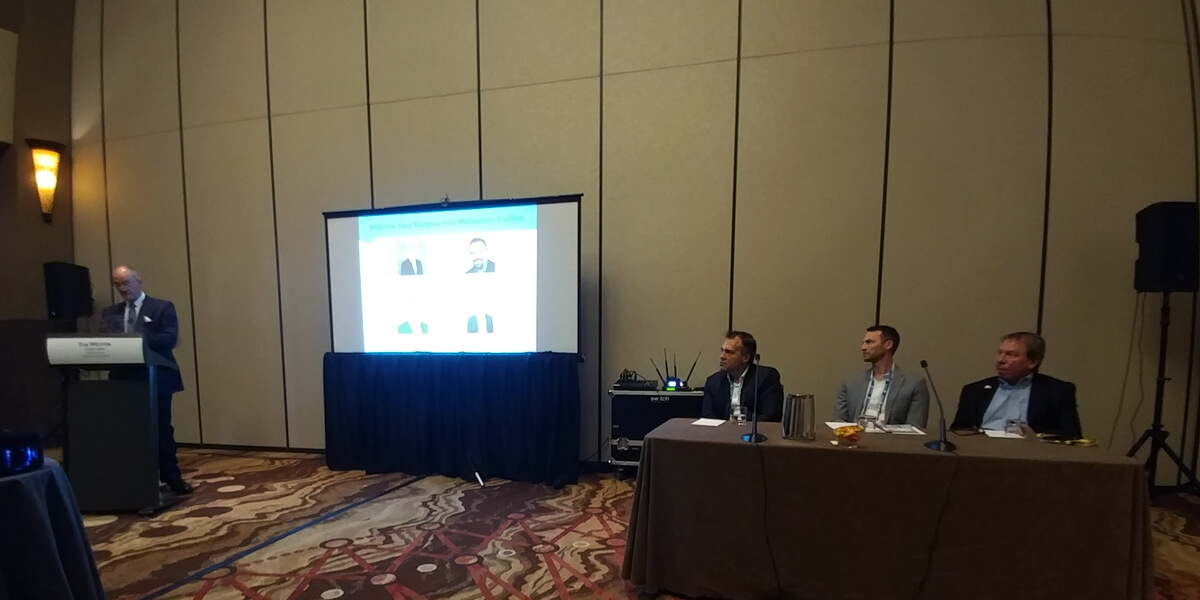Learn from industry experts how mandatory trading improves your margins regardless of market movements. Read this educational article on recent trends in mortgage pipeline hedging and mandatory executions to increase your knowledge.
 The Lenders One 2018 Winter Conference was a mix of inspiring keynotes, new industry perspectives, educational breakout sessions, and deep-dive sessions with lenders on how to optimize their businesses and explore what’s next in the mortgage industry.
The Lenders One 2018 Winter Conference was a mix of inspiring keynotes, new industry perspectives, educational breakout sessions, and deep-dive sessions with lenders on how to optimize their businesses and explore what’s next in the mortgage industry.
Phil Rasori, COO of MCT®, was a speaker on the “Improve Your Margins with Mandatory Trading” panel, which we have published in this article to answer many questions growing lenders may have when considering the transition from best efforts (BE) to mandatory executions. This educational session featured industry experts at the Lenders One 2018 Winter Conference on Tuesday, 3/6/18 at the Westin Keirland Resort & Spa.
This is a recap of the event and contains paraphrasing to put forward the best discussion overview.
Learn to Improve Your Margins – Table of Contents
Read as industry experts dissect each of the following questions as they pertain to recent events and future outlooks. This knowledge comes straight from managing directors, CFOs, and COOs to give you an in-depth look on their perspectives to help you grow as a mortgage or capital markets professional.
- What current trends are you seeing in pipeline hedging and mandatory executions?
- What influence does data have on hedging?
- What’s the difference between selling forward and hedging using TBA’s?
- What are some of the benefits of hedging in terms of investor relationships?
- What is your weekly routine for loan sales?
- What is your stance on offering “last look” opportunities for investors to outbid the competition?
- What are common issues and what pickup can a lender expect when moving to mandatory?
- What is a recent example where detective work improved a client with poor performance relative to their peers?
- How does a rising rate environment play into the hedging piece? What if interest rates take a quick jump?
- At what point in a retail shop does it make economic sense to move to mandatory?
Lenders One Conference: Improve Your Margins with Mandatory Trading
Moderator: Rob Chrisman, Capital Markets Consultant, Chrisman, Inc.
Panel Speakers:
- Don Brown, Managing Director, Secondary Services, Optimal Blue
- Trevor Gates, Chief Financial Officer, Integrity First Financial Group, Inc.
- Philip Rasori, Chief Operating Officer and Hedge Advisory Lead, Mortgage Capital Trading

Pictured from left: Rob Chrisman, Phil Rasori, Trevor Gates, and Don Brown
Question & Answer Discussion on Mandatory Trading
Panel Description: There’s no doubt that best efforts commitments is a way of transferring risk, but in today’s climate, the better mandatory pricing often more than compensates for it. Even if you’ve looked at moving from best efforts to mandatory before and not made a move, it is worth examining again. Learn how you can improve your margins regardless of market move through mandatory trading from experts in the field. You’ll also hear from a lender who brought his shop through the shift from best efforts to mandatory, and why making the leap paid off.
Read through this panel conversation and walk away with industry knowledge like an attendee.

The Lenders One 2018 Winter Conference was set in beautiful Scottsdale to VISUALIZE current and future trends!
The panel first started with moderator Rob Chrisman polling the room to see who is executing Mandatory vs. Best Efforts. Out of a room full of 60+ people the response was 1/3 Mandatory and 2/3 Best Efforts, which was to be expected. The discussion then moved into the question and answer session where each speaker started with their observations of industry trends around pipeline hedging.
What current trends are you seeing in pipeline hedging and mandatory executions?
Don Brown, Managing Director, Secondary Services, Optimal Blue
When I first started in the industry ten or fifteen years ago, the majority of companies were selling best efforts.
There are now very few of those “white elephants” out there who are doing $50-100MM+/mo, who are not hedging. So it is mostly emerging mortgage bankers who are now looking to make this transition. Technology and investor/market pricing transparency has leveled the playing field and allowed a lot more companies to enter the mandatory space.
%
of whole loan sales are executed via bid tape
Some companies still have the “wizard behind the curtain” and are self-hedging using antiquated models or technology. It’s a different landscape doing it in a disconnected spreadsheet vs. the connected systems that exist today. Over the course of the last 36 months there has been a proliferation of new investors entering the space, with 68% of execution going to the bulk-bid channel in our experience. This has allowed correspondent investors to bring spec pay-ups and granularity of price normally reserved for securitization and pools.
Philip Rasori, Chief Operating Officer and Hedge Advisory Lead, Mortgage Capital Trading
The transition of selling whole loans via the bulk bid tape channel is one of the biggest trends we’ve seen in recent years. Another recent trend is that as you see this drop in volume and investors try to fight for what remains, we see the margin between Best Efforts and Mandatory pricing thinning – at least over the short term. As an example, the summer of 2014 was a poor time to hedge. If every period was like that one, hedging probably wouldn’t be as popular.
It is important to know that hedging with mandatory executions is a reversible or temporarily reversible decision for periods when margins thin or volumes fall. Certain large investors can use SRP grids and make it disadvantageous to hedge those loans in these types of environments. This generally isn’t a permanent state of affairs, and you don’t have to hedge everything all the time. Trevor had some experience with this type of environment when we first started working with him.
Trevor Gates, Chief Financial Officer, Integrity First Financial Group, Inc.
When rates were moving fast in 2014 and volumes were dropping, there was a lot of cash flow out due to hedging and it was scary. We were able to back off the strategy, wait out for an improved environment, and re-engage in hedging and mandatory executions soon after.
You need to be at a certain volume level for the spreads between Best Efforts and Mandatory to make sense economically. There are so many benefits to executing on a mandatory basis, such as control over lock extension, flexibility of underwriters to send to multiple outlets, and other operational efficiencies. The pickup is primarily in the short term mandatory lock and shopping for the best price via best execution analysis – a service MCT provides our company.
What influence does data have on hedging?
Don Brown – Hedging is data dependent – good data makes good hedging.
We have had tremendous data improvement in recent years thanks largely to integrations with Loan Origination Systems (LOS) used by lenders.
However, many lenders aren’t using some very relevant fields when they first come to us. For instance – fields to measure when and how loans are falling out to accurately measure pull-through rates. You just didn’t need to use these when executing everything on a Best Efforts basis, but these are typically set up as part of the initial engagement with a hedge advisory firm.
No lender comes with perfect data – part of the exercise we go through is to map the data into the system, scrub the data for problems, and build a system of rules for ongoing data reconciliation. Don’t get too hung up on “my data isn’t perfect yet.” It will get better over time as you focus on it.
What’s the difference between selling forward and hedging using TBA’s?
Phil Rasori – Before three years ago there were many lenders just selling forward commitments with their investors.
This worked well if you have a consistent investor execution so that you could just take out a long-term trade. The main difference now is that investors will pay up for specific characteristics of individual loans. An example is the huge pay-ups for loans below $85,000. There is no economic benefit for the borrower to refinance at this level, which makes the purchaser of the security willing to pay even more than screen prices. By simply selling forward commitments, you may be missing out on these spec pay-ups.
Historically, investor forward commitments have been limited to a one-way pair off. One the other hand, TBA’s and agency forward commitments have a two-way pair off. This means you can take advantage of the positive effects of market movement, rather than being only limited to the negative.
What are some of the benefits of hedging in terms of investor relationships?
Trevor Gates – Some investors will only accept loans on a mandatory basis. An example of this would be Amerihome when they first started, although they do have some Best Efforts pricing now.
Negotiating better pricing with investors is easier when they are competing for your business among a larger pool of possible executions, and when you are able to deliver consistently. MCT is regularly keeping an eye out for the best pricing and new investor opportunities for us as part of the services they provide.
iMarket Monthly Reviews & Investor Performance Reporting
Each month MCT provides clients concise reporting of the market share performance of their mandatory-approved investors. These reports arm you with a “facts and data based” scorecard on how well YOUR investors are doing in winning YOUR business. It also includes a detailed scorecard for each of your top investors about their market share performance (by product) and their overall price competitiveness (via an “opportunity curve”).
Learn how MCT helps you improve performance through detailed data and reporting.
You mentioned you do loan sales twice a week, what is your weekly routine?
Trevor Gates – We use MCT’s Lock Desk Services which has been a huge factor for our business. Centralizing our lock desk with MCT’s support improves the data and helps us manage operationally.
All the loans that we deem ready to ship due to a certain status are generated into a bid tape, which is done twice a week in conjunction with our MCT Trader. MCT’s Bid Auction Manager (BAM) is used to send out the bid tape to investors, collect their bids, and conduct a Best Execution Analysis which also takes our Best Efforts rate sheet pricing and all other possible executions into account. This process makes it easy for me to quickly review and select executions. Because we are using an interest-rate-neutral hedging strategy, we generally don’t need to worry much about the market environment as it relates to loan sales – so twice a week works well for our process and volume.
The fabled “last look” opportunity for an investor to outbid the competition – what is your stance on offering this to investors?
Don Brown – Offering a “last look” affects best execution. Optimal Blue does not give last look; our position is that your best bid should be your first bid. Companies that want a last look generally won’t lead with their best bid because they are trying to leave room to negotiate.
We’re happy to give investors color and provide tools for them to hone their strategy, but operationally last look does not make sense. We have a saying that “you make one friend and a hundred enemies.”
Phil Rasori – We agree with Don that consistently offering an investor “last look” can create an incentive for them to soften their initial bid. However, certain investors will offer to pay lenders more regardless of what their top execution is and take this message directly to the lender. In these situations we counsel the client that offering last look is a dangerous road to go down, but we ultimately leave the decision up to the client.
This problem goes off the table if we enter an eBay-style loan environment with more transparency and better technology. The data and counter-party structure aren’t yet there – but it is certainly on the horizon.
When a lender is talking to you about making the transition to mandatory, what do you see as common issues and what pick-up can they expect?
Phil Rasori – The pick-up is absolutely the biggest question – consultants across the industry will put forward certain numbers for this pick-up, such as 20 basis points on conventional volume and 40 basis points on government volume.
However, this is extremely client-specific. We had a client in Irvine who was thrilled with MCT and wanted to encourage some other prospects in the area to sign up. He kept telling people, “I’m thrilled with MCT, I’ve gotten 13 basis points pickup!” and I had to laugh and say, “Please, stop helping me.”
For this particular lender they would never lock an interest rate until the loan was approved, which resulted in a 96% pull through rate. Since the investors already had certainty of delivery they were happy to pay an excellent Best Efforts price – making their pickup from BE to Mandatory thinner. This shouldn’t be seen as a bad thing! They were already doing well and hedging still brought them a modest pickup and lots of other operational benefits.
basis points pick-up can be expected on Conventional volume
basis points pick-up can be expected on Government volume
What is a recent example where most clients were earning more but one client was earning less and there was something that MCT found and was able to help with?
Phil Rasori – Trevor mentioned moving out of consumer-direct and into a more traditional retail channel. We had a situation when rates rose after the election in 2016 where a client had brought on a retail branch that was using a different Loan Origination System (LOS). The client was merging the pipeline files on their side and making errors. We would always hope that clients would pass both files to us to be vetted and added into our system. Once we fixed the process, they saw their performance drastically increase.
A successful customer is an educated and involved customer. We appreciate the trust that clients put in us, but we do have a few that are very hands-off and these are potential candidates for trouble to happen.
Audience Question: How does a rising rate environment play into the hedging piece? What if interest rates take a quick jump?
Don Brown – The whole point of the hedge is to manage interest rate risk. The hedge impact is designed to be as neutral as possible, while the best execution loan sale piece is where you get your profit pickup.
The largest disruptions we’ve seen in recent years have been in what I call “sudden and sustained” interest rate movements. In these periods, the inefficiencies of some hedge models come through and take time to catch up to the new environment; but not the pull-through based, duration-matching hedge models of Optimal Blue or MCT of course. You should never be short or long intentionally – this is gambling not hedging. When you are caught short or long with a massive movement, this is the disaster scenario that can put companies out of business.
Trevor Gates – One thing we had to learn was to stop thinking of pickup on an individual loan basis. Hedging is a full pipeline, long-term strategy.
Phil Rasori – As an example, in the lead up to the market movements of the 2016 election, Trevor was coming off of two years where loan purchases were a good thing and trade settlements were a bad thing. When the environment changed this situation reversed and trade settlements paid off as intended, insulating him against what could have been significant losses.
Audience Question: At what point in a retail shop does it make economic sense to move to mandatory?
Phil Rasori – Over the years we’ve quoted around $10MM/mo in volume, but you should probably start looking at it even sooner than that.
Don Brown – We’ve seen a client who is consistently under $6MM/mo who is very successful with hedging, but they are extremely operational sound.
million dollars per month in loan volume
Thanks for reading!
We hope you will join the conversation by leaving your perspective in the comments below.
Please contact us and our capital markets experts would be happy to help you learn more.
Related Articles
- Economic Outlook 2018: Interest Rates, Volume, and Market Volatility (Panel Recap)
- White-Label Rate Sheets & Mark to Market Reporting Services
- Tax & Escrows: Calculation & Impact on Servicing Values | Servicing Insights Vol. 6
- Outsourcing Mortgage Operations (Webinar Recap)
- What the FINRA 4210 Mark to Market Rule Means for Lenders
- Secondary Mortgage Marketing Glossary & Definitions







